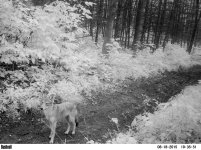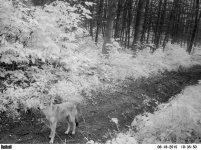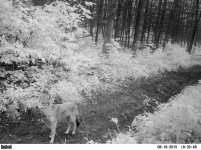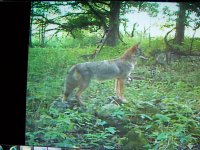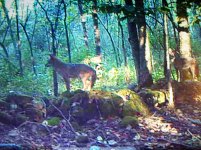Fascinating the amount of fairly current research being devoted to what we've know as the eastern coyote and possibly a subsequent popular name change
Coywolf Publications | Coywolf
"Body mass comparisons Body mass (mean and standard deviation) of western Coyotes (n= 18 populations) were as follows: males = 12.2 kg (SD 1.1), females = 10.7 kg (SD 1.0);
northeastern Coyotes (n= 17): males = 16.5 kg (SD 1.5), females = 14.7 kg (SD 1.5); and Eastern Wolves (n= 6): males = 28.2 kg (SD 2.6), females = 23.7 kg (SD 1.9) (Figure 2) (appendix 1). aNoVa of the three groups of canids revealed significant differences for both males (F2,37 = 242.2, P< 0.0001) and females (F2,35 = 187.9, P< 0.0001). all pair-wise comparisons (e.g., northeastern to western Coyotes, Eastern Wolves to both Coyote groups) were significant (P< 0.0001).
These data can be interpreted as showing that north- eastern Coyotes are statistically intermediate in size be tween western Coyotes and Eastern Wolves, although numerically closer to western Coyotes (Figure 2). al though the largest population of northeastern Coyotes almost approached the smallest Eastern Wolves, there were individual northeastern Coyotes not shown in Figure 2 that overlapped (i.e., 22?5 kg range) the smaller Eastern Wolves (appendix 1). Because north eastern Coyotes were numerically closer to western Coyotes than to Eastern Wolves (Figure 2) (appendix 1), the largest western Coyotes approached the smallest north eastern Coyotes. For instance, female northeastern Coyotes were 20.5% larger than male western Coyotes while female Eastern Wolves were 43.6% larger than male northeastern Coyotes. Effect size was robust for all calculations and comparisons (Table 1). In practical biological terms, adult male Eastern Wolves were on average 1.71 times (71%) heavier than male northeastern Coyotes, which in turn were ca. 1.35 times (35%) heavier than adult male western Coyotes. or put another way, adult male western Coyotes were 74% of the size of male northeastern Coyotes, which in turn were 59% of the size of male Eastern Wolves. Similarly, adult female Eastern Wolves were on average 1.61 times (61%) heavier than female northeastern Coyotes, which in turn were ca. 1.37 times (37%) heavier than adult female western Coyotes. adult female western Coyotes were 73% of the size of female northeastern Coyotes, which in turn were 62% of the size of female Eastern Wolves.

